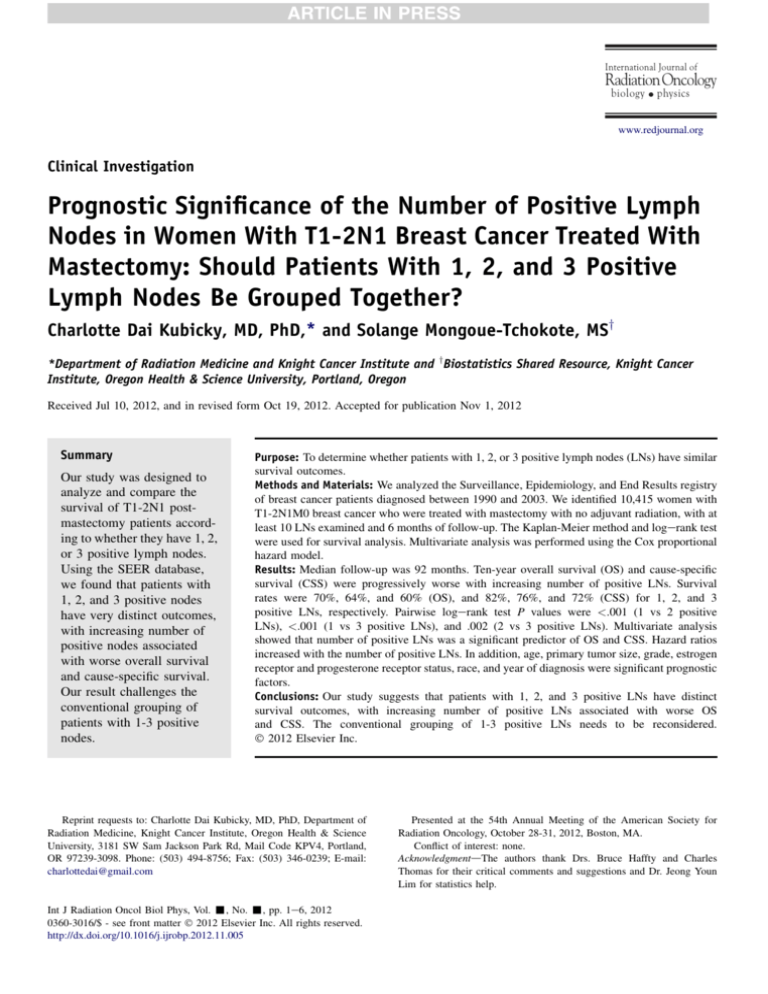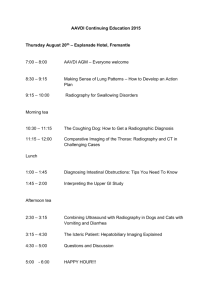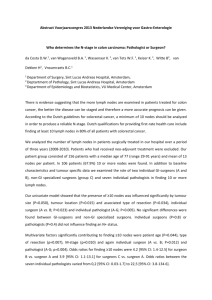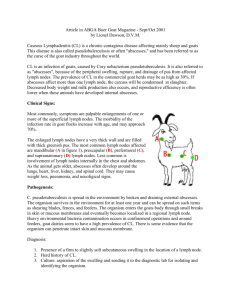
International Journal of
Radiation Oncology
biology
physics
www.redjournal.org
Clinical Investigation
Prognostic Significance of the Number of Positive Lymph
Nodes in Women With T1-2N1 Breast Cancer Treated With
Mastectomy: Should Patients With 1, 2, and 3 Positive
Lymph Nodes Be Grouped Together?
Charlotte Dai Kubicky, MD, PhD,* and Solange Mongoue-Tchokote, MSy
*Department of Radiation Medicine and Knight Cancer Institute and yBiostatistics Shared Resource, Knight Cancer
Institute, Oregon Health & Science University, Portland, Oregon
Received Jul 10, 2012, and in revised form Oct 19, 2012. Accepted for publication Nov 1, 2012
Summary
Our study was designed to
analyze and compare the
survival of T1-2N1 postmastectomy patients according to whether they have 1, 2,
or 3 positive lymph nodes.
Using the SEER database,
we found that patients with
1, 2, and 3 positive nodes
have very distinct outcomes,
with increasing number of
positive nodes associated
with worse overall survival
and cause-specific survival.
Our result challenges the
conventional grouping of
patients with 1-3 positive
nodes.
Purpose: To determine whether patients with 1, 2, or 3 positive lymph nodes (LNs) have similar
survival outcomes.
Methods and Materials: We analyzed the Surveillance, Epidemiology, and End Results registry
of breast cancer patients diagnosed between 1990 and 2003. We identified 10,415 women with
T1-2N1M0 breast cancer who were treated with mastectomy with no adjuvant radiation, with at
least 10 LNs examined and 6 months of follow-up. The Kaplan-Meier method and logerank test
were used for survival analysis. Multivariate analysis was performed using the Cox proportional
hazard model.
Results: Median follow-up was 92 months. Ten-year overall survival (OS) and cause-specific
survival (CSS) were progressively worse with increasing number of positive LNs. Survival
rates were 70%, 64%, and 60% (OS), and 82%, 76%, and 72% (CSS) for 1, 2, and 3
positive LNs, respectively. Pairwise logerank test P values were <.001 (1 vs 2 positive
LNs), <.001 (1 vs 3 positive LNs), and .002 (2 vs 3 positive LNs). Multivariate analysis
showed that number of positive LNs was a significant predictor of OS and CSS. Hazard ratios
increased with the number of positive LNs. In addition, age, primary tumor size, grade, estrogen
receptor and progesterone receptor status, race, and year of diagnosis were significant prognostic
factors.
Conclusions: Our study suggests that patients with 1, 2, and 3 positive LNs have distinct
survival outcomes, with increasing number of positive LNs associated with worse OS
and CSS. The conventional grouping of 1-3 positive LNs needs to be reconsidered.
Ó 2012 Elsevier Inc.
Reprint requests to: Charlotte Dai Kubicky, MD, PhD, Department of
Radiation Medicine, Knight Cancer Institute, Oregon Health & Science
University, 3181 SW Sam Jackson Park Rd, Mail Code KPV4, Portland,
OR 97239-3098. Phone: (503) 494-8756; Fax: (503) 346-0239; E-mail:
charlottedai@gmail.com
Int J Radiation Oncol Biol Phys, Vol. -, No. -, pp. 1e6, 2012
0360-3016/$ - see front matter Ó 2012 Elsevier Inc. All rights reserved.
http://dx.doi.org/10.1016/j.ijrobp.2012.11.005
Presented at the 54th Annual Meeting of the American Society for
Radiation Oncology, October 28-31, 2012, Boston, MA.
Conflict of interest: none.
AcknowledgmentdThe authors thank Drs. Bruce Haffty and Charles
Thomas for their critical comments and suggestions and Dr. Jeong Youn
Lim for statistics help.
2
Dai Kubicky and Mongoue-Tchokote
Introduction
In node-positive breast cancer, the conventional grouping of 1-3
versus 4 involved axillary nodes has been used in making treatment
decisions (1). In 2001, the American Society of Clinical Oncology
recommended postmastectomy radiation therapy (PMRT) in
patients with 4 or more positive lymph nodes (2). However, for
those with tumor <5 cm and 1-3 positive lymph nodes (T1-2N1),
the guideline stated that “There is insufficient evidence to make
recommendations or suggestions for the routine use of PMRT.”
In recent years, the distinction of 1-3 versus 4 positive nodes
and their respective benefit from PMRT has been challenged. A
subset of analysis of the Danish 82b and 82c trials pooled 1152
node-positive patients with at least 8 lymph nodes removed. The
same magnitude of overall survival (OS) benefit was observed for
patients with 1-3 and those with 4 involved lymph nodes (3).
This finding supports the notion that PMRT may be equally
beneficial in patients with 1-3 and 4 positive lymph nodes. In
addition, the Early Breast Cancer Trialist’ Collaborative Group
(4) reported a meta-analysis of 8505 women with lymph nodepositive disease treated with mastectomy and axillary surgery.
They reported a 17% reduction in local recurrence at 5 years,
translating to a 4.4% reduction in overall mortality at 15 years,
supporting a benefit of PMRT in any node-positive patients.
Unfortunately, Intergroup S9923, the phase 3 trial randomizing
women with 1-3 positive nodes to PMRT versus no RT was closed
early in 2003 owing to insufficient accrual.
Along a similar line, the National Cancer Institute of Canada
Clinical Trial Group (NCIC-CTG) MA20 study randomized postlumpectomy patients with 1-3 positive nodes to regional nodal
irradiation (RNI) versus no RNI. Preliminary results at 5 years
showed that the addition of RNI reduced the risk of locoregional and
distant recurrence (5). Regional nodal irradiation also improved
disease-free survival, with a trend toward improved OS. Results of
MA20 can be extrapolated to postmastectomy patients, providing
support for PMRT in T1-2N1 postmastectomy patients. However,
MA20 also raises the question of whether all patients with 1-3
positive lymph nodes should receive PMRT or whether there is an
identifiable cohort that is at higher risk.
Because of the conventional grouping of 1-3 versus 4 positive
lymph nodes in retrospective and prospective studies, outcomes of
patients with 1-3 positive nodes have been analyzed and reported as
a unified group. As such, there is a paucity of data examining
whether, within this group, patients have similar survival outcomes.
Patients with 1 positive node may not necessarily be equal to those
with 2 or 3 positive nodes. In this study, we sought to analyze and
compare the OS and cause-specific survival (CSS) in T1-2N1
postmastectomy patients according to whether they have 1, 2, or 3
positive lymph nodes, using a cohort of women from the Surveillance, Epidemiology, and End Results (SEER) database.
International Journal of Radiation Oncology Biology Physics
doxorubicin-based chemotherapy, (2) patients were less likely to
have received neoadjuvant chemotherapy, and (3) the routine use
of axillary lymph node dissection alone or in conjunction with
a positive sentinel lymph node was prevalent.
We then narrowed the study population to women who
underwent mastectomy with pathologic tumor size 5 cm and
1-3 positive lymph nodes. To avoid the potential confounding
effects of radiation, we excluded patients who received adjuvant
radiation therapy. We also excluded patients with fewer than
10 nodes dissected to ensure adequate nodal clearance. From this
cohort, we further excluded those with <6 months of follow-up,
bilateral tumors, stage IV disease at presentation, and history
of prior malignancies. In addition, patients with incomplete
information regarding grade (2786), estrogen receptor (ER) status
(2670), and progesterone receptor (PR) status (376) were
excluded. A total of 10,415 women formed the study population.
Study endpoints
Methods and Materials
Primary endpoint was OS, defined as the interval between the date
of diagnosis and the date of death from any cause. The secondary
end point was CSS, defined as the interval between the date of
diagnosis and the date of death from breast cancer. Individuals
with unknown cause of death were censored, but not excluded, in
the breast cancer CSS analysis.
Follow-up time was calculated from the month and year of initial
diagnosis to the date of last contact or death. Vital status and data of
last contact were available for all patients. The follow-up time was
available through December 2008 at the time of analysis.
According to SEER (www.seer.gov), “.cancer registries use
algorithms to process causes of death from death certificate in
order to identify a single, disease-specific, underlying cause of
death. In some cases, attribution of a single cause of death may be
difficult and misattribution may occur. For example a death may
be attributed to the site of metastasis instead of the primary site..
To capture deaths related to the specific cancer but not coded as
such, the SEER cause-specific death classification variables are
defined by taking into account causes of deaths in conjunction
with tumor sequence (ie, only one tumor or the first of subsequent
tumors), site of the original cancer diagnosis, co-morbidities (eg,
AIDS and/or site-related diseases).”
The reliability of using death certificates in determining CSS
has been examined. German et al (6) reported a concordance
rate >90% for breast cancer when comparing cause of death from
death certificates recorded by the state and cancer site recorded by
registry. In patients with distant-stage disease, Lund et al (7) reported 85% agreement between coded cause of death and initial
diagnosis. A recent study by Howlader et al (8) reported similar
estimates of relative survival and CSS for breast cancer calculated
from SEER, supporting the use CSS in estimating cancer
mortality, especially when suitable life tables are not available to
calculate relative survival.
Study population
Statistical analysis
The SEER cancer registry maintained by the National Cancer
Institute was used to identify the patient population for this study.
We identified women with pathologically confirmed invasive
breast cancer diagnosed between 1990 and 2003. We chose this
time period because (1) patients were more likely to have received
Pearson’s c2 test was used to assess the associations between 1, 2,
and 3 positive lymph nodes groups and covariates.
Survival estimates were calculated using the Kaplan-Meier
method and reported with their 95% confidence intervals for 5-,
10-, and 15-year time points. We compared OS and CSS between
Volume - Number - 2012
For multiple pair-wise comparisons, the Bonferroni correction was
used to assess for clinical significance, with P value defined as
P < .05/n, where n is the number of comparisons. Statistical
analysis was performed using IBM Statistics SPSS 20 (Armonk,
NY) and STATA (StataCorp, College Station, TX).
nodal subgroups using the logerank test. To determine whether
the number of positive lymph nodes is an independent predictor of
OS and/or CSS, we performed multivariate analysis using the Cox
proportional hazard model. Age, tumor size, number of positive
lymph nodes, grade, ER and PR status, year of diagnosis, and race
were included as variables. Year of diagnosis has been shown to be
a prognostic factor in a number of studies, with more recent years
of diagnosis correlating with lower risk of death and breast cancerspecific death (9-11). We included year of diagnosis in the
multivariate analysis to reduce any confounding effect of this
variable on the number of positive lymph nodes.
Data were reported as hazard ratios with their 95% confidence
intervals. Statistical significance was defined as a P value <.05.
Table 1
3
Different survival in women with 1, 2 or 3 nodes
Results
Of the 10,415 patients included in the study, the median age was
57 years (range, 23-97 years). The median tumor size was 21 mm
(range, 1-50 mm). The median number of nodes examined was 15
(range, 10-57). Table 1 summarizes the patient characteristics.
Clinical characteristics of the entire study population and according to the number of positive lymph nodes
Positive nodes
Variable
Total
1
N
Age at diagnosis (y)
40
41-50
51-59
60
Median
Range
Year of diagnosis
1990-1994
1995-1999
2000-2003
Tumor size
T1
T2
Median
Range
Grade
Well differentiated
Moderately differentiated
Poor or undifferentiated
ER status
Positive
Negative
PR status
Positive
Negative
Nodes examined
15
>15
Median
Range
Nodal ratio (%)
<20
20
Race
White
Black
Other or unknown
10,145
5606
1129
2470
2223
4593
57
23-97
589
1298
1199
2520
2
3051
P*
3
1758
.28
(11)
(23)
(21)
(45)
327
739
656
1329
(11)
(24)
(21)
(44)
213
433
368
744
(12)
(25)
(21)
(42)
.014
2709
3137
4569
1419 (25)
1648 (29)
2539 (45)
798 (26)
942 (31)
1311 (43)
492 (28)
547 (31)
719 (41)
5054
5361
21
0.1-5
2947 (53)
2659 (47)
1401 (46)
1650 (54)
706 (40)
1052 (60)
1041
4637
4737
635 (11)
2503 (45)
2468 (44)
281 (9)
1368 (45)
1402 (46)
125 (7)
766 (44)
867 (49)
7934
2481
4291 (77)
1315 (23)
2313 (76)
738 (24)
1330 (76)
428 (24)
6927
3488
3731 (67)
1875 (33)
2023 (66)
1028 (34)
1173 (67)
585 (33)
5341
5074
15
10-57
2950 (53)
2656 (47)
1543 (51)
1508 (49)
848 (48)
910 (52)
9723
692
5606 (100)
0 (0)
3051 (100)
0 (0)
1066 (61)
692 (39)
8595
911
909
4695 (84)
442 (8)
469 (8)
2481 (81)
292 (10)
278 (9)
1419 (81)
177 (10)
162 (9)
<.0001
<.0001
.64
.95
.0038
<.0001
.0053
Abbreviations: ER Z estrogen receptor; nodal ratio Z number of positive lymph nodes divided by the total number of lymph nodes dissected;
PR Z progesterone receptor.
Values are number (percentage).
* Pearson’s c2 test.
4
Dai Kubicky and Mongoue-Tchokote
In all, 5606 (54%), 3051 (29%), and 1758 (17%) patients had 1, 2,
and 3 positive lymph nodes, respectively. Regarding treatment, all
patients underwent mastectomy, and no patients received PMRT.
Because of the limitation of the SEER registry, systemic therapy
information was not available for the study cohort.
Median follow-up was 92 months. Kaplan-Meier estimates of
OS and CSS, stratified by the number of positive lymph nodes,
showed progressively worse survival with increasing number of
positive lymph nodes (Fig. 1). Pairwise logerank test P values were
<.001 (1 vs 2 positive LNs), <.001 (1 vs 3 positive LNs), and .002
(2 vs 3 positive LNs) for both OS and CSS. Table 2 lists 5-, 10-, and
15-year OS and CSS survival rates with their 95% confidence
intervals, stratified by the number of positive lymph nodes.
To determine whether the number of positive lymph nodes is
an independent predictor of OS and CSS, we performed multivariate analyses using the Cox proportional hazard model
(Tables 3 and 4). The result showed that the hazard of death from
breast cancer and from any cause increased with the number of
positive lymph nodes. For OS, the hazard ratio was 1.150,
comparing 2 versus 1 positive LNs. The hazard ratio increased to
1.324, comparing 3 versus 1 positive LNs. For CSS, the hazard
ratio increased from 1.324, comparing 2 versus 1 positive LNs, to
1.538 comparing 3 versus 1 positive LNs (all P values <.001).
International Journal of Radiation Oncology Biology Physics
Table 2 Kaplan-Meier overall survival and cause-specific
survival by the number of positive lymph nodes
Survival rates, % (95% CI)
Parameter
1 positive LN
2 positive LNs
3 positive LNs
85 (84-86)
70 (68-71)
57 (55-59)
82 (80-83)
64 (62-66)
53 (50-56)
78 (76-80)
60 (58-63)
47 (43-50)
91 (90-92)
82 (81-84)
77 (75-78)
87 (86-88)
76 (75-78)
70 (67-72)
85 (83-86)
72 (70-75)
63 (60-67)
OS
5y
10 y
15 y
CSS
5y
10 y
15 y
Abbreviations: CI Z confidence interval; CSS Z cause-specific
survival; LN Z lymph node; OS Z overall survival.
In addition, age, primary tumor size, grade, ER and PR status,
race, and year of diagnosis were significant predictors of OS and
CSS (Tables 3 and 4).
Discussion
Our study is among the first to separately analyze and compare
survival outcomes of patients according to whether they have 1, 2,
or 3 positive lymph nodes. It demonstrated clear differences in
survival among this group of patients, with increasing number of
Table 3 Multivariate Cox proportional hazard analysis of
overall survival
Variable
Fig. 1. Overall survival (A) and cause-specific survival (B) for
all patients stratified by the number of positive lymph nodes.
Pairwise logerank P values are shown above. Clinical significance defined as P < .05/3, or .0167.
Age at diagnosis (y)
40
41-50
51-59
60
Tumor size
T1
T2
Grade
Well differentiated
Moderately differentiated
Poor or undifferentiated
ER status
Positive
Negative
PR status
Positive
Negative
Positive lymph nodes
1
2
3
Race
White
Black
Other
Year of diagnosis (per y)
HR
95% CI
P
Reference
0.778
0.674-0.898
.001
0.929
0.805-1.073
.317
2.359
2.089-2.664 <.001
Reference
1.568
1.463-1.681 <.001
Reference
1.309
1.137-1.506 <.001
1.598
1.386-1.842 <.001
Reference
1.158
1.050-1.277
.003
Reference
1.204
1.102-1.315 <.001
Reference
1.15
1.064-1.242 <.001
1.324
1.211-1.446 <.001
Reference
1.326
1.189-1.478 <.001
0.786
0.686-0.899 <.001
0.962
0.954-0.971 <.001
Abbreviations: CI Z confidence interval; HR Z hazard ratio.
Volume - Number - 2012
Different survival in women with 1, 2 or 3 nodes
Table 4 Multivariate Cox proportional hazard analysis of
cause-specific survival
Variable
Age at diagnosis (y)
40
41-50
51-59
60
Tumor size
T1
T2
Grade
Well differentiated
Moderately differentiated
Poor or undifferentiated
ER status
Positive
Negative
PR status
Positive
Negative
Positive lymph nodes
1
2
3
Race
White
Black
Other
Year of diagnosis (per y)
HR
95% CI
Reference
0.807
0.694-0.938
0.846
0.724-0.988
1.158
1.009-1.329
P
.005
.035
.036
Reference
1.733
1.579-1.902 <.001
Reference
1.712
1.356-2.162 <.001
2.54
2.013-3.204 <.001
Reference
1.296
1.144-1.467 <.001
Reference
1.321
1.175-1.486 <.001
Reference
1.324
1.197-1.465 <.001
1.538
1.372-1.724 <.001
Reference
1.328
1.160-1.521 <.001
0.865
0.733-1.020
.086
0.95
0.939-0.961 <.001
Abbreviations: CI Z confidence interval; HR Z hazard ratio.
positive lymph nodes associated with worse OS and CSS. The
similar trend observed for both OS and CSS suggests that
mortality from breast cancer remains a significant cause of death
in this population.
Tai et al (12) published a similar study using the populationbased Saskatchewan provincial registry. They included 755
patients who underwent lumpectomy or mastectomy. Approximately 40% received adjuvant radiation therapy. Nineteen percent
received supraclavicular and axillary nodal irradiation. Tai et al
reported similar OS and CSS in those with 1 and 2 positive nodes
and a worse survival outcome in those with 3 positive nodes. In
multivariate analysis, the higher number of positive nodes
(1-2 vs 3) predicted worse CSS. However, the inclusion of
radiation patients complicates the interpretation of their results
because radiation has been shown to improve survival. For this
reason, we specifically excluded radiation patients in our study.
Our results are consistent with that reported by Vinh-Hung et al
(11). They conducted a SEER analysis of 4787 patients with T1-2
node-positive breast cancer who underwent mastectomy without
adjuvant radiation therapy. The authors found a continuum of
worse outcome associated with increasing number of positive
lymph nodes. They were not able to identify a prognostic cutoff in
the number positive lymph nodes. Our findings and that by VinhHung et al (11) challenge the conventional risk grouping of 1-3
versus 4 positive nodes and the assumption that 1-3 positive nodes
cancers “behave” similarly. It suggests a continuum of increasing
number of lymph nodes associated with worse outcome.
5
Our study has several limitations. First, it lacks information on
systemic therapy. Chemotherapy and endocrine therapy have been
shown to impact survival. However, one could postulate that
women with 3 positive nodes were more likely to receive
chemotherapy than those with 1 positive lymph node. Despite that,
the 3 positive nodes cohort still had worse survival, suggesting the
lack of systemic therapy information is not likely to change
the conclusion of the study. Second, under-coding of radiation in
the SEER registry has been reported (13), especially in those who
underwent mastectomy and chemotherapy. Even though our intent
was to exclude those who received PMRT, it is possible that some
were accidentally included owing to under-ascertainment of
radiation receipt by SEER. A similar argument can be made that
women with 3 positive nodes were more likely to receive PMRT
than those with 1 positive node; yet the 3 positive nodes cohort
still had worse survival, suggesting radiation under-coding is not
likely to affect the result. Third, important clinical and pathologic
variables that impact locoregional control and survival are not
recorded in SEER, such as margin status, angiolymphatic invasion, extracapsular extension, HER-2/neu status, and medical
comorbidities. Therefore, we were unable to account for their
impact in our analysis. Fourth, as discussed in detail in Methods
and Materials, SEER uses death certificates to determine CSS.
This approach has disadvantages, because misattribution of death
may occur. However, several studies have demonstrated reasonable accuracy in breast cancer, supporting the validity of using
cause-specific survival in our investigation (6-8). Last, owing to
the inherent limitation of the SEER database, we are not able to
provide information on locoregional recurrence and patterns of
failure. As a result, there is a missing link between the number of
lymph nodes and locoregional recurrence. Hence, we are not able
to draw conclusions on whether the heterogeneity within the
1-3 positive nodes cohort has any implications on the benefits
of PMRT.
Are involved lymph nodes simply a prognostic factor, or are
they also markers of locoregional disease that can respond to
surgery and radiation? Can PMRT change the survival patterns of
women with 1, 2, or 3 positive lymph nodes? These questions have
been long debated and are certainly beyond the scope of our study.
However, our study does suggest that T1-2N1 patients are a more
heterogeneous group than previously thought. Patients with 1
positive node do not equal those with 2 or 3 positive nodes. Many
radiation oncologists found the 5-year disease-free survival benefit
in the MA20 trial (5) somewhat unexpected. A very simple
explanation may be that the trial may have included more patients
with 2 or 3 positive lymph nodes, shifting the patient population
toward a higher risk group. An analysis of the percentage makeup
of the nodal subsets may shed light on what patients are most
likely to derive benefit from regional nodal irradiation.
The heterogeneity of T1-2N1 patients may also reflect a wide
spectrum of competing risks of locoregional versus systemic
disease, perhaps more so than in those with 4 or more positive
lymph nodes and in T1-2 node-negative patients. One could
postulate that in some T1-2N1 patients, locoregional disease is the
source of dissemination and radiation to the chest wall and
regional nodes can directly impact survival. In others, the intrinsic
malignant potential of the tumor may ultimately dictate disease
outcome regardless of the success of locoregional treatment.
It is possible that the number of involved lymph nodes and
other clinical factors are simply surrogates of molecular signatures
that ultimately distinguish cancers from one another. Molecular
profiling of breast cancers was initially developed to assess the
6
Dai Kubicky and Mongoue-Tchokote
risk of systemic disease (14). The 21-gene expression assay
(Oncotype-DX; Genomic Health, Redwood City, CA) and the 70gene expression profile (Mammaprint; Agendia, Amsterdam, The
Netherlands) have been incorporated into clinical practice to help
guide the individualized decision on systemic therapy. Until
recently, data on molecular predictors of locoregional recurrence
have been lacking. In 2010 Voduc et al showed that molecular
subtypes, such as luminal-A, luminal-B, HER-2-enriched, or
basal, are predictive of locoregional recurrence (15, 16). The 21gene Oncotype-Dx recurrence score has also been associated with
the risk of locoregional disease (17). However, these predictive
factors require further validation before they can be used clinically. Other predictors that may be more specific to locoregional
recurrence are yet to be identified. These findings underscore the
importance of developing individualized prediction algorithms
incorporating clinical, pathologic, and molecular characteristics in
making treatment decisions. Radiation oncology, as a field, has
traditionally relied solely on clinicopathologic factors in making
treatment plans. In the future, not only the number of lymph
nodes, tumor size, or grade are important, but also the intrinsic
genetic signatures that may dictate the biology of each tumor.
Conclusion
Our study suggests that T1-2 patients with 1, 2, and 3 positive
lymph nodes have distinct survival outcomes, with increasing
number of positive lymph nodes associated with worse OS and
CSS. The heterogeneity observed in this cohort may explain the
inconsistencies in the previously conducted studies on the role of
PMRT in T1-2N1 patients. It is possible the percentage makeup of
patients with 1, 2, and 3 positive lymph nodes may influence the
study outcome. Our result challenges the conventional grouping
of 1-3 positive lymph nodes. However, because of the inherent
limitation of the SEER database, our study does not provide
information on the association between the number of positive
lymph nodes and locoregional recurrence. Thus, whether the
distinct survival outcomes observed in patients with 1, 2, and 3
involved lymph nodes may be affected by PMRT remains to be
determined.
References
1. Pierce LJ. The use of radiotherapy after mastectomy: A review of the
literature. J Clin Oncol 2005;23:1706-1717.
International Journal of Radiation Oncology Biology Physics
2. Recht A, Edge SB, Solin LJ, et al. Postmastectomy radiotherapy:
clinical practice guidelines of the American Society of Clinical
Oncology. J Clin Oncol 2001;19(5):1539-1569.
3. Overgaard M, Nielsen HM, Overgaard J. Is the benefit of postmastectomy irradiation limited to patients with four or more positive
nodes, as recommended in international consensus reports? A
subgroup analysis of the DBCG 82 b&c randomized trials. Radiother
Oncol 2007;82:247-253.
4. Clarke M, Collins R, Darby S, et al. Effects of radiotherapy and of
differences in the extent of surgery for early breast cancer on local
recurrence and 15-year survival: an overview of the randomised trials.
Lancet 2005;366(9503):2087-2106.
5. Whelan TJ, Olivotto I, Ackerman I, et al. NCIC CTG MA.20: An
intergroup trial of regional nodal irradiation in early breast cancer. J
Clin Oncol 2011;29(15 Suppl): LAB 1003.
6. German RR, Fink AK, Heron M, et al. The accuracy of cancer
mortality statistics based on death certificates in the United States.
Cancer Epidemiol 2011;35(2):126-131.
7. Lund JL, Harlan LC, Yabroff KR, et al. Should cause of death from the
death certificate be used to examine cancer-specific survival? A study of
patients with distant stage disease. Cancer Invest 2010;28(7):758-764.
8. Howlader N, Ries LA, Mariotto AB, et al. Improved estimates of
cancer-specific survival rates from population-based data. J Natl
Cancer Inst 2010;102(20):1584-1598.
9. Smith BD, Smith GL, Haffty BG. Postmastectomy radiation and
mortality in women with T1-2 node-positive breast cancer. J Clin
Oncol 2005;23:1409-1419.
10. Chen SL, Hoehne FM, Giuliano AE. The prognostic significance of
micrometastases in breast cancer: A SEER population-based analysis.
Ann Surg Oncol 2007;14:3378-3384.
11. Vinh-Hung V, Storme G. No nodal cutoff in node-positive breast
cancer women treated with mastectomy. Breast Cancer Res Treat
2006;98:173-178.
12. Tai P, Yu E, Joseph K. Prognostic significance of number of positive
nodes: A long-term study of one to two nodes versus three nodes in
breast cancer patients. Int J Radiat Oncol Biol Phys 2010;77:180-187.
13. Jagsi R, Abrahamse P, Hawley ST, et al. Underascertainment of
radiotherapy receipt in Surveillance, Epidemiology, and End Results
registry data. Cancer 2012;118(2):333-341.
14. Sorlie T, Perou CM, Tibshirani R, et al. Gene expression patterns of
breast carcinomas distinguish tumor subclasses with clinical implications. Proc Natl Acad Sci U S A 2001;98(19):10869-10874.
15. Haffty BG, Buchholz TA. Molecular predictors of locoregional
recurrence in breast cancer: Ready for prime time? J Clin Oncol 2010;
28:1627-1629.
16. Voduc KD, Cheang MC, Tyldesley S, et al. Breast cancer subtypes and the
risk of local and regional relapse. J Clin Oncol 2010;28(10):1684-1691.
17. Mamounas EP, Tang G, Fisher B, et al. Association between the 21-gene
recurrence score assay and risk of locoregional recurrence in nodenegative, estrogen receptor-positive breast cancer: results from NSABP
B-14 and NSABP B-20. J Clin Oncol 2010;28(10):1677-1683.








